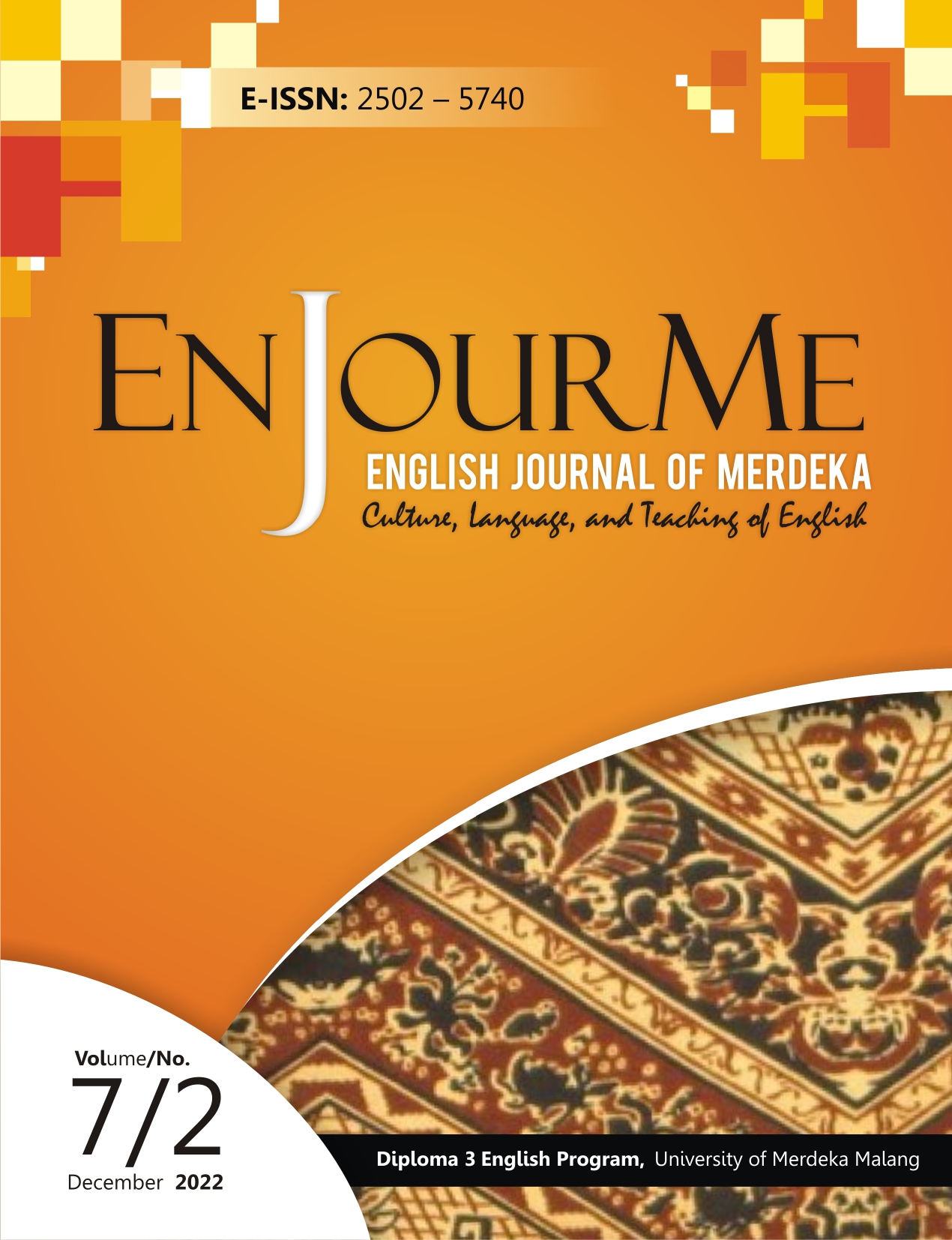Employing video-editing skill in designing materials for Speaking class
DOI:
https://doi.org/10.26905/enjourme.v7i2.8817Keywords:
Digitalized learning, learning materials, speaking class, teaching speaking, and video-editing skill.Abstract
This study sought to prove whether there is an inclination in students’ ability before and after video-editing treatments.This study was carried out under the umbrella of quasi-experimental study as it involved one group pretes-posttest design. There were 13 students chosen through the procedure of total sampling. They were given a pretest to make 3 videos—3 minutes in duration each—in topic of Describing People, Inviting People, and Accepting and Refusing Invitation. Later, six treatments were given: three treatments of video-editing and three other were about material design. Afterwards, the post-test was essentially similar with pretest regarding the procedural means. The data were analyzed using SPSS 22 by employing the formula of normality test and Z-Score to perform hypothesis testing. The results uncovered that the null hypothesis (H0) is rejected and the alternative hypothesis (Ha) is consequently accepted because the rvalue obtained from the Z-Score is 2.63, which is higher than rtable= 0.47 (df=11, α=0.05, right tailed). Additionlly, the average score for the 13 samples before applying video editing procedures was 56.23, and after the treatments, this score incilned to be 79.Then in can be concuded that after obtaining the treatments, students' performance in terms of video editing abilities with reference to material design or speaking class has necessarily improved. The finding implies that it is best to train teacher and prospective teachers with video-editing ability to enable them design good and convenient teaching materials in the future where digital era has transmerged into all pedagogical aspects.
DOI:Â 10.26905/enjourme.v7i2.8817
Downloads
References
Albahiri, M. H., & Alhaj, A. A. M. (2020). Role of visual element in spoken English discourse: Implications for youtube technology in EFL classrooms. The Electronic Library, 38, 531-544.
Al Hosni, S. (2014). Speaking difficulties encountered by young EFL learners. International Journal on Studies in English Language and Literature, 2(6), 22–30.
Fakhruddin, Z., Usman., Rahmawati., & Sulvinajayanti. (2020). Designing English listening materials through youtube video editing: Training for English teachers of islamic junior high schools, Parepare, South Sulawesi. ish Listening Materials through YouTube Video Editing. Indonesian Journal of English Language Teaching and Applied Linguistics, 4(2), 275-290.
Senel, M. (2012). Oral communication anxiety and problems of Turkish EFL learners at Samsun 19 Mayis University, ELT department. Frontiers of Language and Teaching, 3, 49–58.
Brown, H. D. (2001). Teaching by principles: An interactive approach to language pedagogy. White Plains: Longman.
Lazarton, A. (2001). Teaching oral skills. In Celce-Murcia, M (ed.), Teaching English as a Second or Foreign Language. Boston: Heinle & Heinle, 103–115.
Aleksandrzak, M. (2011). Problems and challenges in teaching and learning speaking at advanced learning. Glottodidactica, 37, 37–48.
Harmer, J. (2007). The practice of English language teaching. Harlow: Pearson Education.
Hinkel, E. (2006). Current perspectives on teaching the four skills. TESOL Quarterly, 4(1), 109–131.
Hojat, A., & Afghari, A. (2013). An investigation of speaking-associated problems from students and instructors perspectives. Iranian EFL Journal, 9(4), 9–31.
Rababah, G. (2005). Communication problems facing Arab learners of English: Journal of Language and Learning, 3(1), 1740-4983.
Albahiri, M. H., & Alhaj, A. A. M. (2020). Role of visual element in spoken English discourse: Implications for Youtube technology in EFL classrooms. The Electronic Library, 38, 531-544.
Mohammed, M.A.A. (2020). Utilizing technology in ELT classrooms. Open Access Library Journal, 7, e606.
Kausar, G. (2013). Students’ perspective of the use of audio visual aids in Pakistan. International Proceedings of Economics Development and Research. Sichuan: IACSIT Press, 11-19.
Muslem, A., Gani, S. A., Usman, B., Rismawati., & Yunus, M. M. (2018). The influence of authentic English video clips on students’ listening comprehension. The New Educational Review, 53, 105-114.
Cakir, I. (2006). Evaluation of the EFL textbook “New Bridge to Succes 3†from the Perspectives of Students and Teachers. (Unpublished master’s thesis). The Middle East Technical University, Ankara, Turkey.
Stenglin, M., & Iedema, R. (2001). How to analyse visual images: A guide for TESOL teachers. In A. Burns, A., & Coffin, C (eds.), Analysing English in a global context—A Reader. New York, Routledge/Open University/Macquarie University, 194-208.
Halliday, M. A. K., and Matthiesen, C. M. I. M. (2004). An introduction to functional Grammar. New York: Oxford University Press.
Sugiyono. (2013). Metode penelitian kuantitatif, kualitatif, dan kombinasi [Quantitative, qualitative, and combination research methods]. Bandung: Alfabeta.
Suharsaputra. (2012). Metode penelitian [Research methods]. Bandung: PT Refika Aditama.
Kress, G. & Van Leeuwen, T. (2006). Reading images: The grammar of visual design. London: Routledge.
Additional Files
Published
How to Cite
Issue
Section
License
Authors who publish with this journal agree to the following terms:
(1) Copyright of the published articles will be transferred to the journal as the publisher of the manuscripts. Therefore, the author confirms that the copyright has been managed by the journal.
(2) Publisher of EnJourMe (English Journal of Merdeka) : Culture, Language, and Teaching of English is University of Merdeka Malang.
(3) The copyright follows Creative Commons Attribution–ShareAlike License (CC BY SA): This license allows to Share — copy and redistribute the material in any medium or format, Adapt — remix, transform, and build upon the material, for any purpose, even commercially.




